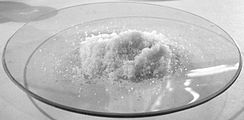Ammonium carbonate

| |

| |

| |
| Names | |
|---|---|
| IUPAC name
Ammonium carbonate
| |
Other names
| |
| Identifiers | |
| |
3D model (
JSmol ) |
|
| ChEBI | |
| ChemSpider | |
ECHA InfoCard
|
100.007.326 |
| EC Number |
|
| E number | E503(i) (acidity regulators, ...) |
IUPHAR/BPS |
|
PubChem CID
|
|
| UNII | |
| UN number | 3077 |
CompTox Dashboard (EPA)
|
|
| |
| |
| Properties | |
| (NH4)2CO3 | |
| Molar mass | 96.09 g/mol |
| Appearance | White powder |
| Density | 1.50 g/cm3 |
| Melting point | 58 °C (136 °F; 331 K) (decomposes) |
| 100 g/100 ml (15°C)[1] 25 g/100 ml (20°C) | |
| -42.50·10−6 cm3/mol | |
| Hazards | |
| Occupational safety and health (OHS/OSH): | |
Main hazards
|
Irritant |
| GHS labelling: | |

| |
| Warning | |
| H302, H319 | |
| Safety data sheet (SDS) | External MSDS |
| Related compounds | |
Other anions
|
Ammonium bicarbonate Ammonium carbamate |
Other cations
|
Sodium carbonate Potassium carbonate |
Except where otherwise noted, data are given for materials in their standard state (at 25 °C [77 °F], 100 kPa).
| |
Ammonium carbonate is a salt with the chemical formula (NH4)2CO3. Since it readily degrades to gaseous ammonia and carbon dioxide upon heating, it is used as a
Production
Ammonium carbonate is produced by combining carbon dioxide and aqueous ammonia. About 80,000 tons/year were produced as of 1997.
An orthorhombic monohydrate is known. It crystallizes in an ammonia solution exposed in a carbon dioxide-rich atmosphere.[3]
Decomposition
Ammonium carbonate slowly decomposes at standard temperature and pressure through two pathways. Thus any initially pure sample of ammonium carbonate will soon become a mixture including various byproducts.
Ammonium carbonate can spontaneously
Which further decomposes to carbon dioxide, water and another molecule of ammonia:
Uses
Leavening agent
Ammonium carbonate may be used as a
). It was the precursor to today's more commonly used baking powder.Originally made from ground deer horn and called hartshorn, today it is called baker's ammonia. It is prepared by the sublimation of a mixture of ammonium sulfate and calcium carbonate and occurs as a white powder or a hard, white or translucent mass.[4] It acts as a heat activated leavening agent and breaks down into carbon dioxide (leavening), ammonia (which needs to dissipate) and water. It is sometimes combined with sodium bicarbonate to mimic as a double acting baking powder and to help mask any ammonia smell not baked out.
It also serves as an acidity regulator and has the E number E503. It can be replaced with baking powder, but this may affect both the taste and texture of the finished product. Baker's ammonia should be used to create thin dry baked goods like crackers and cookies. This allows the strong ammonia smell to bake out. It should not be used to make moist baked items like cake since ammonia is hydrophilic and will leave a strong bitter taste.
Its use as a leavening agent, with associated controversy, goes back centuries:
In the third kind of
carbonic acid gas.[5]
Other uses
Ammonium carbonate is the main component of
It is also used for luring of apple maggots in Washington State, to monitor the spread of the infestation and adjust the borders of the Apple Maggot Quarantine Area.[6]
See also
- Ammonium bicarbonate
- Ammonium nitrate
- Sal ammoniac, the mineralogical form of ammonium chloride
References
- ISBN 978-1138561632.
- ^ ISBN 978-3527306732.
- PMID 25449618. Retrieved 2021-08-20.
- ^ "CFR - Code of Federal Regulations Title 21". www.accessdata.fda.gov. Retrieved 2018-02-07.
- ^ "Bread". The Engineer's and Mechanic's Encyclopedia. Vol. 1. Luke Hebert. 1849. p. 239.
- S2CID 31174719.



